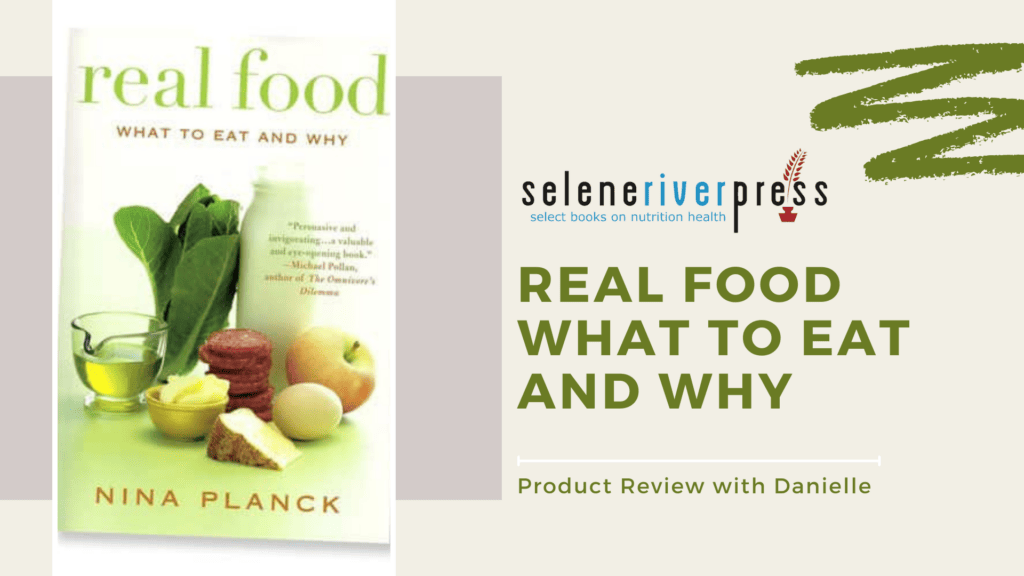Hey everyone, it’s Danielle again from Selene River Press. For my product review, I want to talk about Real Food: What to Eat and Why by Nina Planck.
I love this book. Throughout my years with SRP, I have learned so much about the truth of holistic nutrition, whole food nutrition, why organic really does matter, raw milk and dairy products and the importance of them and avoiding common health misconceptions that we’re told in the world. I’ve done product reviews on Put Your Money Where Your Mouth Is! Guide to Healthy Food Shopping, Gallbladder Matters (learning about gallbladder health), The Untold Story of Milk (learning about raw milk and why raw milk is so important), and so many other dozens of products and hundreds of blog posts where we talk about this topic.
I love the book Real Food because all of this information that I’ve learned comes together in this book. For example, where Nina talks about some very dangerous misconceptions of what old diets used to be in ancient people and to the misconceptions that have turned from them and what we have now. More ancient people ate a lot more animal protein and had much more organic foods. Now we’ve almost vilified that, especially animal proteins. And we’re vilifying it and saying why they’re wrong, yet sneakily trying to tell people that these low-fat diets, zero sugars full of artificial sweeteners, saturated fats, and corn syrup, that these are the right way to go. We are killing ourselves as a people because of it.
In Nina’s book, there’s so many places I dogeared where she gives us specific examples, percentages of companies and the dangers they have, and the top dangerous produce items. I’m going to talk about a couple of them quickly and give a few studies so when you buy this book, you can reference them yourself.
One that I love is in the beginning she talks about the modern American diet versus traditional diet. We look at the Inuit tribes of North America and the Evenki shepherds in Russia. We’re comparing those to modern Americans, particularly seeing how these native tribes have a much higher percentage of animal foods, (and let’s notate that they’re healthy animal foods) and we see that their cholesterol and their BMI are very healthy and normal. Studies have been done on these tribes to figure out why they’re eating these diets that we as modern Americans are saying are so bad for you, yet they’re much healthier.
In this other fascinating study, she talks about the percentage of these chicken companies that are carrying a drug resistant Campylobacter bacteria. The fact that I can barely pronounce that should put a little fear in you to say, “Yeah, I can barely pronounce that and that is in the foods that I’m eating.” This one I really wanted to cry about. Tyson is 96%. When you go to the grocery store, Tyson chicken is everywhere, I’ve eaten a lot of it, I bought it for my family because it’s so affordable. I’ve thought, “This is great. Let’s get Tyson chicken!” But 96%! She then goes into some other ones too. That definitely humbled me and scared me a little bit.
Now, we jump over here to talk about wild fish. I think that we can all understand how wild fish compared to farming is going to have a lot of dangers to it as well. She again just has these beautiful charts that talk exactly about percentages of fats of omegas between wild and farm fish. I mean, it really gives you a beautiful illustration that will stick with you of why these things matter.
It’s so easy to say, “organic is better, but is it really that big a deal? You know, Tyson is super cheap. It’s probably not that much unhealthier than the other one.” Well, when you go from 96% of a bacteria to 5%, yeah, it’s a pretty big difference.
Another section that we talked about in the, and this one was really hard, is some of the most contaminated and least contaminated produce that we get. In the most contaminated, we have a list of fruits and vegetables, all the way from peaches at 100%. She even explains what kind of contaminants these are, but I don’t want to give away all the details because I want you to buy this book and read it for yourself.
Like I said, I have just so many places that I have dogeared in this book that I can easily jump to and read and learn from. Needless to say, I’m going to make sure I buy organic peaches next time. I’m definitely going to get my peaches from a farmers market and I’m not buying them from the store anymore. 100% contaminated! 96% Tyson farms! Oh my goodness!
I’m not going to keep being afraid to eat my animal proteins or think maybe I should go vegan because that’s what everybody talks about. That the people that are vegan are living to 100 years old. And that’s what I need to do. No, I’m going to stop. And I’m going to learn the truth. And I’m going to research it and I’m going to read it through amazing products like Real Food. Nina says something that I think beautifully illustrates this.
“Everywhere I go. People are afraid of real food.”
What a shocking, shocking truth that if we think about is very true.
Whether this is for you or someone you know, please pick this up. Get this in your library. It’ll change your life. It’ll change there’s. I promise it’s a great resource for you. Thanks so much for checking this out! Bye.


